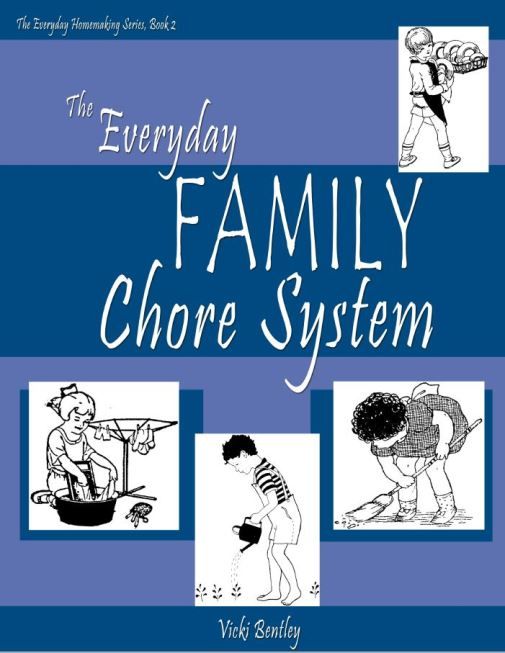Curricula for the kids aren't the only products I get to review as a member of the Homeschool Review Crew. This one from Everyday Homemaking is more for me--and any parent really, not just homeschoolers. One might think that since I'm a full-time, stay-at-home mom that I have this whole thing under control. Ha. While I absolutely love being a homemaker and all that entails (even the cleaning!), I struggle like anyone else to get it all done. That's why it's important to have a system in place for accountability and structure.
I take my role as "mom" very seriously. Not only is it my responsibility to teach my little ones reading, math, and history, it's also my duty to train them in life skills, too. When it comes to working around the house, The Everyday Family Chore System makes it easy to organize the responsibilities.
As a mother of 8 daughters and a foster mom of almost 50, Vicki Bentley has experience in raising children and teaching them what it means to be a "responsible, caring, sharing part of your family." She wrote this book to help other moms see what worked for her family and to give them the tools necessary to implement the program. The book is broken into the following sections:
- Introduction
- Part One: Laying a Foundation
- Part Two: Implementing the Plan
- Part Three: The Actual Chore System
- Suggested Resources
In Laying a Foundation, Vicki explains the purpose of her chore system, in that it's meant to train your children to be responsible members of the family that diligently serve one another and to disciple them in life skills. She talks about having the proper expectations, establishing standards, having a working knowledge of family discipline, and showing your kids love.
"If you don't have time to do it right, you sure don't have time to do it over!"
~ Vicki Bentley
Implementing the Plan gets down to the nitty gritty details. She includes a life skills checklist that acts as a guideline for training children. Each age from 2-teens has a list of possible skills in which you might begin to train the child to do. In parentheses after each skill is the age which the child might be able to complete the task on his own. For example, you might choose to start teaching a 3-year-old how to dust furniture, but he might not be able to properly do it on his own until age 9. Or you may train a 7-year-old to clean the bathroom, but he may not fully hone the skill until he is 12. She is very clear that this list is simply a guideline to help you, not to be followed strictly. Each child is different and has different abilities. As an example, she lists baking a cake and making pancakes starting at age 10 and being fully capable by ages 14 and 16 respectively. In our home, both of those skills are reached on their own, years before her suggested age of 10. It is a lengthy list that includes more than cooking and cleaning, as there are skills such as building a fire, filling out a job application, changing flat tires, planning a workable budget, and much more.
In this section, she also describes the plan and gives suggestions of ways to set it up. She even has many tips you can implement to help your kids succeed, like having a routine, having a place for everything, labeling, making your home child-friendly, and others.
Part three is The Actual Chore System, meaning it contains printable cards for your system. There are individual card labels that name the jobs. They include the most common family chores and then there are several empty labels so you can customize your list for your own family.
There are also How-To-Do-It Cards that correspond to the majority of the jobs and a few extras. These 3x5 cards explain step-by-step how the task should be accomplished. This ensures that the child does a thorough job and does not forget any steps. It also acts as accountability so he can't claim that he didn't know a specific portion needed to be done. Some of the cards have blank spaces so you can fill in your chosen cleaner. I laminated all of my cards for stability and chose to do so without the blanks filled in. This way, if I decide to change my cleaner, I won't need to replace the card. I simply write on the laminated card with an overhead transparency marker, or a wet-erase marker. This way, the ink is semi-permanent, but can easily be changed with a little water and cloth.
There are many different ways you can put the system together. I chose to use a plastic pocket chart that I used during my teaching-in-the-classroom days many years ago. This was incredibly simply to use, because once I had my cards printed, cut, and laminated, all I had to do was fill the pockets. The chart can stand up on its own, or I can collapse it to hide it away. There is also a large velcro pocket in the inside that I use to store the How-To-Do-It cards that are part of the weekly jobs in the chart.
As far as the other cards, I keep those in a 3x5 card box. Those are the jobs that don't need to be completed as often. We use these tasks for various things: weekly job from box, disciplinary purposes, seasonal cleaning, ect..
"Don't put it down; put it away!" ~ Vicki Bentley
I have seen many variations of chore charts over the years, but never one quite like this. This one isn't simply a list of age-appropriate tasks and a way to organize them, but includes valuable information explaining exactly how the child should complete them. The How-To-Do-It cards make this system stand out above the rest.
My kids are doing very well with this format. It's easy to keep track of the chores for the week and helps them to see what they need to do. They especially like doing the jobs from the box and often ask if they can do extras! We'll see how long that enthusiasm for extra chores lasts, ha.
Vicki also wrote a cookbook with tried-and-true recipes that we reviewed years ago. She is currently offering 10% off the Everyday Family Chore System and Everyday Cooking with coupon code TOS10books through September 5. The code is good for both the printed and digital versions.
If you'd like to read more reviews of the chore system or check out some reviews of the cookbook, please visit the Homeschool Review Crew blog.






Thanks so much for reviewing the system. I love your pocket stand--I have one just like it (shown in one of my articles on organization) and it's one of the many fun ways to set up the system. So glad you found ways to customize the system for your individual family! Thanks again for your thoughtful review.
ReplyDelete